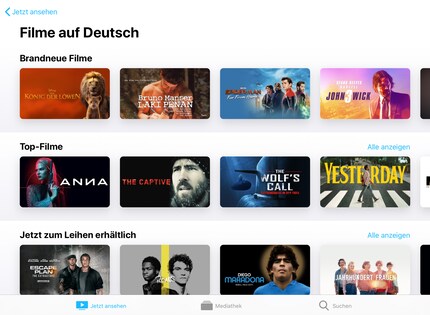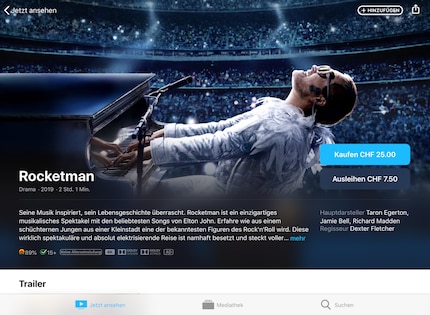
Product test
Apple Arcade: makes even an Android user like myself jealous
by Philipp Rüegg

Apple TV+ is upon us. The new kid on the streaming scene has spent a whopping six billion dollars on its original productions to date. What appears to be mindless money burning actually works. But it’s not what you think.
Apple has spent six billion dollars on original productions or Apple Originals. That’s the same amount the Swiss federal government paid to bail out UBS and save the bank from going bankrupt in 2008. To start with, there will be eight series and one documentary. Four more series are to be added «soon». To put this into perspective: Netflix spent around 13 billion dollars on its originals in 2018. However, the amount financed 23 movies and over 300 series.
So how can Apple's six billion dollar marketing trick – disguised as a streaming service – possibly work? Especially considering that new Apple customers get the service for free for a year, as our reader Marco_CH commented in my Apple TV+ review [/en/page/apple-tv-plus-ist-it-really-so-bad-14390#comments]:
I purposely bought a new iPhone to get Apple’s streaming service for free for 1 year. I sure outsmarted Apple. No way am I paying for such little content :D
Let's do the maths.
Apple execs Jamie Erlicht and Zack Van Amburg are said to have gone over the approved budget by around five billion dollars. This fits in with a Bloomberg article stating that the first two seasons of «The Morning Show» cost 300 million dollars. With two seasons at eight episodes each, that’s slightly more than 18 million dollars per episode.
To put this into perspective: On average, a «Game of Thrones» episode from season eight cost 15 million dollars.

For this to pay off financially, Apple's strategy is probably something like this: start off by recruiting as large a customer base as possible; cash in later when prices are increased. That's nothing new in the business. Netflix has already shown us how. And unlike Netflix, Apple has another ace up its sleeve: additional sales.
In Apple’s case, additional sales are those generated by the sale and rental of their on-demand range. Apple TV+ is a mere extension of Apple TV – that’s the on-demand range, not the box, which has the exact same name.
In other words: every Apple TV+ subscriber is also a potential Apple TV customer – and vice versa.

This raises the question of where this colossal customer base is supposed to come from. According to CNBC, analysts expect Apple to sell about 70 million iPhones by the end of this year. And millions of Macs, iPads and Apple TVs. All buyers get a year of Apple TV+ for free.
Ta-dah! There’s that customer base for you.
I think we all agree that it’s unlikely the company will convince all iPhone purchasers to stick to Apple TV+ after their trial year is up.
However, the company has one year to convince as many customers as possible to stay on board – with good content and a steady stream of new shows. I’ll bet you that, a year from now, there will be a lot of cliffhangers in the series. A very low subscription price of five dollars per month – or six francs here – also helps. Focusing on quality instead of quantity may also be a clever strategy.
Today, Apple is still miles away from this kind of dream scenario. Their selection is too small to be taken seriously. And must-see content such as «Stranger Things» or «The Boys» – to name but a few examples from Netflix and Amazon Prime – is still missing. However, the chosen strategy of keeping the selection small but high in quality, like «See» or «For All Mankind», is promising.
As soon as Apple is sure of its customer base, subscription prices will go up. Having said that, the current subscription price of five dollars a month already pays off for Apple. Let’s assume that all of the predicted 70 million iPhone customers will keep their subscriptions. This corresponds to an annual revenue of 4.2 billion dollars. And that’s not including the millions of customers who will buy another Apple device.

That's just a numbers game. A possible scenario. Undoubtedly, Apple must have thought through dozens of scenarios. And concluded that the risk was worth it.
To put this into perspective: At the end of 2018, Netflix had 139 million subscribers. Meanwhile they’ve probably exceeded the 150 million mark. Amazon Prime had a total of [105 million] subscribers (https://www.statista.com/statistics/546894/number-of-amazon-prime-paying-members/) in June 2019. Even though Disney+ is not yet available worldwide, it still attracted 10 million subscribers at launch. This corresponds to an annual turnover of 838.8 million dollars or 69.9 million dollars a month.
So it doesn't seem impossible that Apple will secure a subscriber base in the millions over the next few years by means of low subscription prices and elaborately produced series.
Above, I hypothesised about 4.2 billion in revenue without a price increase. After all, the budget for the first few documentaries and one or two seasons per series was 6 billion dollars. The remaining difference could be partially covered by income generated by purchase and rental fees for the remaining on-demand content available on Apple TV. The rest by Apple device sales boosted by Apple TV+ and other services.
And there it is. The marketing trick: boosting sales of Apple devices.
For Apple's big advantage is that it does things differently to Netflix. Apple is still a company that predominantly sells iPhones. On top of that, sales of Macs and iPads are on the rise, as are revenues generated by Apple Store and Apple Pay Services.
How does Apple TV+ fit in?
One of Apple's guarantees for success is that they produce the hardware for iPhones and Co. and operate it with their own software. iOS and macOS to name but a few. Now Apple also wants to control the content played on it. This creates an Apple ecosystem that looks like its been cast from a single mould. The company already has a music service. And it recently launched an exclusive service for mobile gaming called Apple Arcade. All that’s missing now are series and films.
Apple TV+ is the next logical step in Apple's drive to control the value chain of the entire entertainment industry: from hardware to software and the content streamed on it. All that’s missing now is camera equipment. This suggests that it's only a matter of time before Apple provides the infrastructure for Hollywood.
In this context, Apple TV+ doesn't even have to be a profitable service. At least not primarily. All Apple TV+ needs to do is boost iPhone sales so that they’re making more than the service is costing the company. Like a marketing tool disguised as a streaming service that’s helping to sell iPhones and other Apple devices. After all, the exclusivity of these kinds of services is a great way for Apple to advertise its devices: Want Apple TV+? Buy an iPhone and get it free. For now.
Netflix is a different story. Their streaming service is not a marketing tool but the business model itself. The company needs to generate profits from subscription revenues, otherwise Netflix is doomed. But not Apple. Apple's core business is selling iPhones, iPads, iWatches and Macs.
Apple TV+ only plays the role of the most expensive customer loyalty programme of all time.
I write about technology as if it were cinema, and about films as if they were real life. Between bits and blockbusters, I’m after stories that move people, not just generate clicks. And yes – sometimes I listen to film scores louder than I probably should.
Interesting facts about products, behind-the-scenes looks at manufacturers and deep-dives on interesting people.
Show all